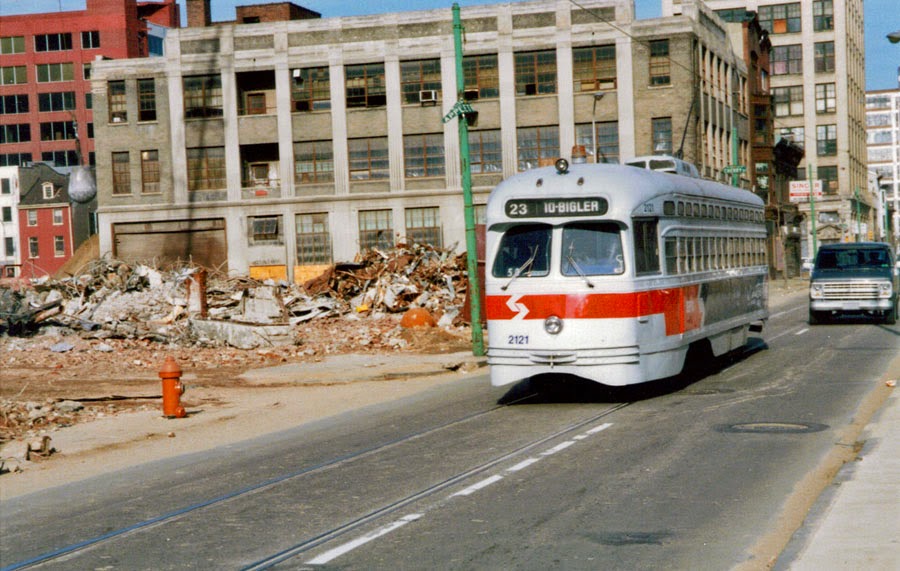It's led at least one person to call this corner Hole Foods.
The premier Parkway-adjacent address at 21st and Hamilton, and the already-excavated land, offer something the Dalian doesn't have: underground parking. A former project abandoned after the Great Recession had already begun construction, so aside from some concrete and rebar, the site is prepped. The Dalian greets Hamilton Street with a glassy facade, but hovers over 21st and buildings along Spring Garden with a hulking and uninviting parking garage. Tom Bock's condominium tower, designed by Cecil Baker & Partners, stands to be far more dynamic with the kind of sunken and unseen parking that should be the rule for all urban developments.
Although Curbed and The Inquirer both mentioned the Rail Park's master plan, which runs through the defunct railroad tunnel that would become this project's parking garage, Friends of the Rail Park have yet to comment.
They might not. The first phase of the Rail Park is scheduled to open this spring and the second phase hasn't been fleshed out. As mapped on the Friends' site, "The Cut" is the mostly-open rail canyon that ends near 22nd and Hamilton. "The Tunnel," easily the most ambitious piece of the park, runs under Pennsylvania Avenue before traveling parallel to the freight tracks that separate the Poplar neighborhood from Lemon Hill. The latter is a favorite of urban explorers and photographers attracted to its vaulted roof and unusual lighting, and easy access to something off-limits. That's also why it's on the Rail Park's site map.
It is a stunning sight to behold, especially in its current state. But the Rail Park itself is a gamble, and how Phase 1 pans out will dictate how it moves forward. Often compared to Manhattan's High Line Park, the Reading Viaduct runs through a more rough-and-tumble part of town. Although Callowhill and Spring Garden are gentrifying rapidly (the Callowhill ZIP code is the forth fastest gentrifying in the country), it will be a long time before the Rail Park offers views of much more than parking lots. It's appeal, like its subterranean western extension, has always been in nature's reclamation and the excitement of trespassing. Sanitized as it will become as a park, it may simply become a place for neighborhood residents to walk their dogs once the novelty wears off.
Even Manhattan's High Line, though lauded and popular, is new. Elevated parks aren't traditional and require structural maintenance, not just seasonal gardening. Time will tell if they're sustainable or if, even in Manhattan, they become the target of inevitable budget cuts down the road. The Rail Park's underground component is a greater gamble in that it's largely untested. While it's fascinating in its current state, it's a one- or two-time destination. As a recreational trail it's just long, dark, and monotonous. Once you leave "The Cut" you're essentially walking into an abandoned subway tunnel, and the westernmost end past the vaulted ceiling is not particularly interesting. In fact, it's western entrance is a bit frightening, coupled by the fact that you'll be walking through the massive, concrete catacomb alongside an active freight line. No amount of lighting will make anyone want to push a stroller through it for a mid-morning walk.
Short of a mandatory Civic Design Review, Tom Back has what he needs to move forward with or without consensus from the Friends of the Rail Park. Given the infancy of the park, it would be hard for Friends to argue such a premier address remain a hole in the ground on the off-chance that they may someday find the means and need to open the tunnel to recreation. It may be for the best, too. Closing the hole will allow those vested in the Rail Park to focus all their efforts on the assets above the ground. Perhaps someday, "The Cut" will connect Callowhill to the heart of the Parkway District. In the meantime, the subterranean tunnel beneath Pennsylvania Avenue will remain the realm of the adventurous looking for more mystique than a park, deep beneath the confines of SoDoSoPa.



























